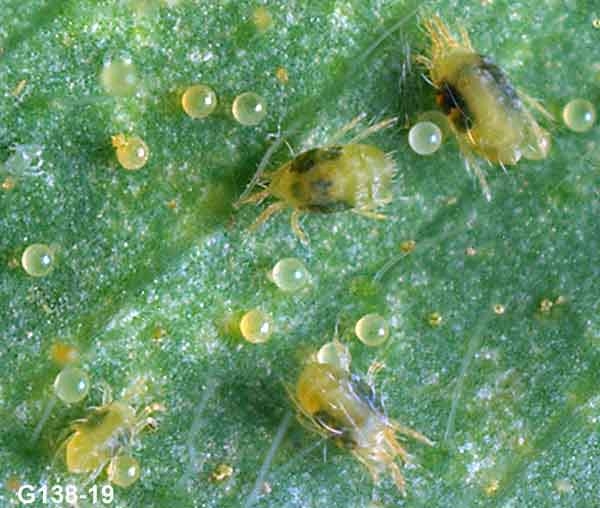Two spotted spider mite (Tetranychus urticae) is native to Eurasia but has become established worldwide.
A major pest problem in the warmer temperate fruit production areas—and again here this year after the severe heat event in late February through to early March.
The situation is parallel to the article in Tree Fruit January 2015: Carpophilus & Qfly control threaten IPM systems with extreme heat events and very high TSM populations, but just how fast can TSM increase?
Rapid population increases
Two spotted spider mites prefer warm, dry conditions to develop and reproduce.
Optimal temperatures are between 20C and 35C with low relative humidity between 30% and 50%.
Development from egg to adult may take 14 days at 21C, down to seven days at temperatures of 29C.
As temperatures increase, TSM fecundity (rate of reproduction) also increases from 1.7 eggs/female/ day at 15C, to 7.1 eggs/female/day at 30C.
On average a female TSM lives for 22 days at 15C and produces about 38 eggs, but only lives for 17 days at 30C producing about 121 eggs.
Appreciate the exponential population growth
A recap to get a meaningful appreciation of this: at 30C a female will live for around 17 days and produce over 120 eggs! With a life cycle of around 7 days. As these eggs hatch and develop into adults that lay more eggs, the population explosion is staggering.
At this rate populations grow exponentially (something like the log scale when measuring soil pH). The TSM population reaches damaging levels horribly quickly.
Given the recent sting of hot days and nights in some parts of the fruit growing areas, we can appreciate the blow-out in the TSM population.
Couple this TSM population explosion with the decline in predators because of the extreme weather, and the TSM can get out of control exceedingly fast.
Biological control of TSM
A paper, Can two-spotted mite be controlled by predatory mite releases in irrigated maize crops? by A.H. Nicholas and K.A. Coutts of NSW DPI, confirmed that two spotted mite is highly adapted to exploit crop hosts with ideal conditions for development being hot (13C to 35C) and dry, and with low in-crop humidity and a water stressed host.
The work in this paper is very pertinent as it was conducted in the MIA (Murrumbidgee Irrigation Area of NSW) and studied our main TSM predators.
We know that biological control of TSM based on predatory mites, Phytoseiulus persimilis (Ahias-Henriot) and Galendromus (Typhlodromus) occidentalis (Nesbitt), has been successful in a number of crops, including apples, stonefruit, strawberries, ornamental and cut flowers and vegetables.
Phytoseiulus persimilis can consume 20 young or 7 adult TSM/day and at 25C reproduce at twice the rate of TSM. It is suited to moderate temperatures, high humidity and crops with heavy foliage.
Galandromus (Typhlodromus) occidentalis, the main predatory mite in northern Victoria, is suited to hot dry conditions.
Adult G. occidentalis can consume 5–15 TSM/day and, reaching maturity 7–8 days compared with TSM’s 14–17 days, reproduces at the rate of 2–3 eggs/day for 24 days. Galandromus occidentalis is best suited to temperatures of 27C to 32C but can tolerate 40+C.
New predatory mite (continued next month)
See this article in Tree Fruit March 2016




















